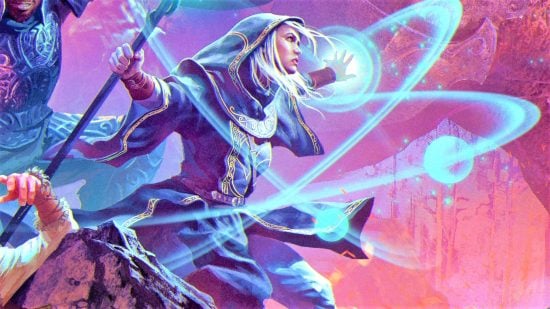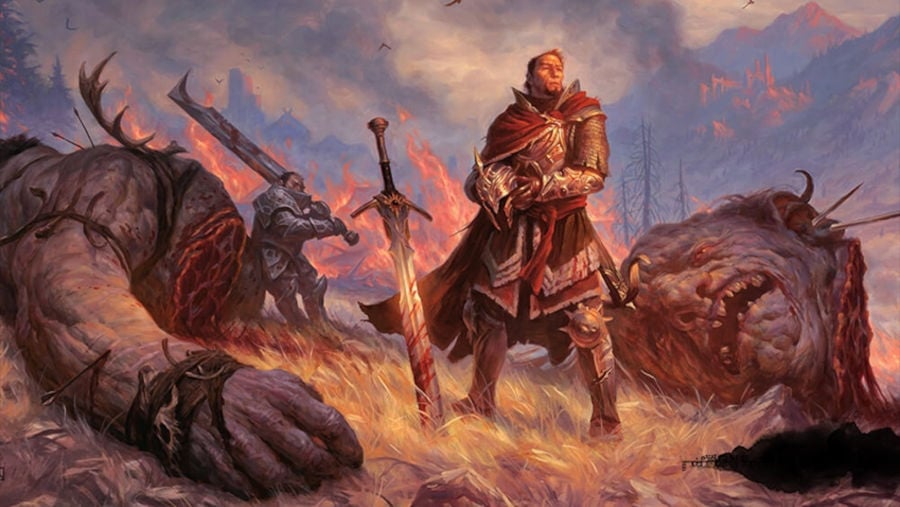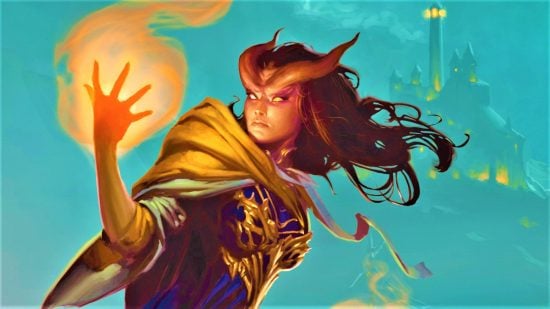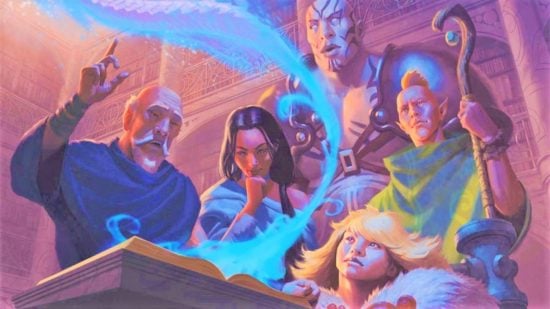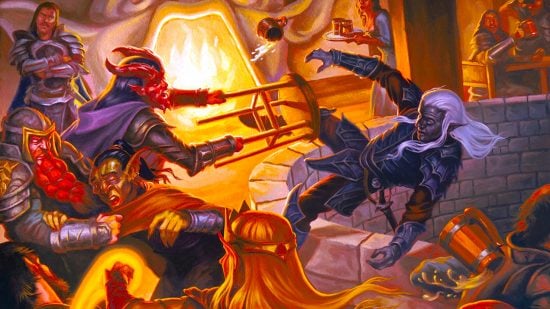DnD feats are optional special abilities that offer a huge range of ways to customize your Dungeons and Dragons character. Some are so powerful that entire character builds are based around them, while others are only worth taking if you have some really funny roleplay in mind. For anyone who needs help finding their feet, we’ve put together a Dungeons and Dragons feat tier list.
We’ve selected a handful of the best (and worst) D&D feats, explaining how they work and why we love or loathe them. Plus, we’ll explain which DnD classes and DnD character builds work best with our choices. After that, it’s up to you to send your feat-filled character out into the fictional world.
Here’s our DnD feats tier list:
- S-tier DnD feats – the most powerful choices
- A-tier DnD feats – excellent, but a little more balanced
- B-tier DnD feats – great for specific builds
- C-tier DnD feats – average, occasionally worth taking
- Worst DnD feats – don’t waste your time on these
What are DnD feats?
DnD feats are additional customization options that give your character new abilities and/or ability score bonuses. Any time you’re asked to make an ability score increase during a DnD level up, you can instead opt to take a feat. You may be able to choose feats earlier, for example if you’re playing a Variant DnD Human.
Many feats have prerequisites you must fulfil in order to take the feat, and you’re unable to use your feat if your ability to meet those conditions ever changes. Some feats in newer books may even require you to take certain starter feats before you can access others.
S-Tier DnD feats
These DnD feats are the best of the best, period. Some take your character build to the next level, letting you take actions that’ll make your Dungeon Master sweat. Some offer so much utility that they’re a must-have for certain classes, while others are just downright fun.
Be sure to check them out with a critical eye, though. These 5e feats aren’t one-size-fits-all, so you’ll need to carefully consider which is right for your character.
Great Weapon Master 5e
How it works
- When your melee weapon scores a critical hit or reduces a creature to zero hit points, make a melee weapon attack as a bonus action.
- Before any melee attack with a heavy weapon you’re proficient in, you can take a -5 penalty to your attack roll in exchange for +10 damage on a successful hit.
Why we love it
In a game where action economy can make or break a fight, extra attacks are an enormous advantage. If you’re playing a martial character who doesn’t spend their bonus actions often (like DnD Barbarian and many DnD Fighters), Great Weapon Master 5e can help you land an alarming number of blows.
A penalty to your weapon’s accuracy may sound like cause for concern, but it’s not as much of a disadvantage as it first seems. Characters with a high-enough Strength modifier are likely to hit more than they miss, even with this minus modifier. Plus, you can combine this with any number of features that’ll improve your chances to hit. Fighters who take the Great Weapon Fighting Style can literally reroll weapon attack rolls of 1 or 2, for example.
Give in to your inner Tank, and deal that extra damage. Great Weapon Master is the foundation of many frightening melee builds.
War Caster 5e
How it works
- Advantage on spell concentration saves after taking damage.
- You can cast spells with somatic components while holding weapons or a shield in both hands.
- When you get to make a DnD opportunity attack, you can cast a spell that usually costs one action and affects one target.
Why we love it
War Caster 5e is only for classes that can cast spells, but it’s essential if you’re planning to play any combination of martial and spellcasting in combat. Not to mention the fact that most squishy spellcasters could benefit from the armor class bonus of a DnD shield.
Some DnD subclasses rely on this mix of magic and melee, like the Circle of Spores DnD Druid or the Bladesinging Wizard 5e. War Caster allows these characters to take up sword and board, charge into battle, and not worry about whether their Haste 5e spell will be cut short. Plus, a cheeky spell in place of an attack of opportunity opens up plenty of strategic possibilities.
Polearm Master 5e
How it works
- After attacking with a glaive, halberd, quarterstaff, or spear, you can make a melee attack as a bonus action (1d4 bludgeoning damage).
- Wielding one of these weapons triggers opportunity attacks when enemies enter the weapon’s reach.
Why we love it
Polearm Master 5e has a reputation. It’s infamous for creating ridiculously powerful martial builds, particularly for DnD Paladins and some 5e Fighters. Giving your party’s best Striker an extra attack (which deals 1d4 plus your ability modifier in damage) makes for excellent action economy.
And we can’t overstate how useful the attack of opportunity is when you’re wielding a pole with ten feet of reach. Greater reach makes it less likely that an enemy will leave your area of reach, but they’ll enter it far more often. More consistent opportunity attacks add yet another attack action to your stack.
What makes this feat even more appealing is how well it interacts with other excellent feats. Depending on the exact weapon you’re wielding, you could create a tasty build by adding Great Weapon Master, Sentinel, War Caster, Shield Master…the list goes on.
Sharpshooter 5e
How it works
- No disadvantage on long ranged weapon attack rolls.
- Ranged weapon attacks ignore half cover and three-quarters cover.
- Before making a ranged weapon attack, you can take a -5 attack roll penalty in exchange for a +10 damage bonus on a successful hit.
Why we love it
Sharpshooter 5e is basically Great Weapon Master for ranged attackers. You can boost your damage in exchange for a minor penalty to your attack roll. And, as we explain earlier in this guide, this isn’t as much of a drawback as it might first seem. You’re still likely to land hits, and there are plenty of ways to sweeten the odds a little.
As well as this damage bonus, you lose the disadvantage imposed by long range, and you can shoot through everything but full cover. This makes shooting bows and crossbows simpler – and much more deadly. DnD Rangers, Fighters focusing on ranged attacks, and the odd DnD Rogue will see plenty of value here.
Lucky 5e
How it works
- You have three luck points per DnD long rest, which can be spent to roll an extra d20 for attack rolls, ability checks, or saving throws. You choose which of the d20s to use for the roll.
- Can be used to change enemy attack rolls as well as your own.
Why we love it
Don’t like what you rolled? Do it again. That’s the basic premise behind Lucky 5e. Putting your fate in the hands of the dice a second time might still turn out badly, but it can seriously stack the odds of the game in your favor.
Lucky has so many game-bending possibilities that it can be a controversial choice of feat, and some DMs may be reluctant to allow it. If you want to pull the ‘it’s what my character would do!’ card, we recommend giving it to a character who would have an in-game reason to manipulate fate. Think the particularly fortunate DnD Halflings, or a class like the DnD Divination Wizard or the Wild Magic Sorcerer 5e.
A-Tier DnD feats
They may not have made the top grade, but these DnD feats are still an excellent addition to your build. Their effects are a little less broken, yes. However, there’s a lot of utility and creativity to be found here.
Magic Initiate 5e
How it works
- Learn two cantrips from one of the following spell lists: Bard, Cleric, Druid, Sorcerer, Warlock, or Wizard.
- You learn a first-level DnD spell from the same list, and you can cast it once per long rest.
- Spellcasting ability for these extra spells depends on which class you chose.
Why we like it
The possibility for non-magic users to add some seriously effective spells to their repertoire is a powerful one. Magic Initiate 5e can create a party where everyone can cast a DnD Fireball, and it lets everyone take potshots with DnD Eldritch blast. Even spellcasters can benefit from effective low-level spells usually outside of their reach, and DnD Warlocks, especially, will be pleased to have another spell that doesn’t consume their scarce spell slots.
It’s a simple benefit with limited daily uses, but the power to learn any spell can lead to a variety of creative, flavorful, and powerful character builds.
Fey Touched 5e
How it works
- +1 Wisdom, Charisma, or Intelligence.
- Learn to cast Misty Step and a first-level Divination or Enchantment spell of your choice without using a spell slot (once per long rest).
- Your spellcasting ability for these spells is the DnD stat you chose to increase.
Why we like it
Any feat that gives you an ability score increase has value. Plus, if you can’t already cast Misty Step, gaining access to the teleportation spell is a huge boon. And on top of that, like Magic Initiate, Fey Touched 5e gives you access to all class spell lists.
You may be limited to two DnD schools of magic, but there are still plenty of build-enhancing options to choose from. Guidance, Bless, and Detect Magic are all strong staples, and the infamous Silvery Barbs is on this list too.
Sentinel 5e
How it works
- Creatures hit by your opportunity attacks have a speed of zero for the rest of the turn.
- Creatures still trigger attacks of opportunity if they Disengage.
- Any time a creature within five feet attacks someone other than you, you can make a melee weapon attack as a reaction.
Why we like it
Extra chances to attack? Check. Improved control over the battlefield? Check. Making life harder for enemy NPCs? Check, check, and check. Sentinel 5e is a great way to toughen up your frontline fighter. Plus, it synergises well with other melee-focused feats – Polearm Master and Sentinel is a match that haunts many Dungeon Masters.
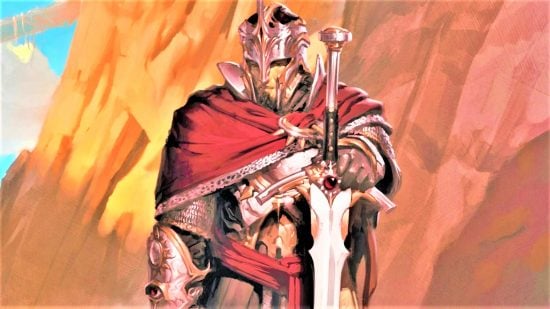
B-Tier DnD feats
These DnD feats are still good, and they can be great when paired with the right build. But the powers they offer are more generalized – or simply less impressive when compared with the higher tiers.
Telekinetic 5e
How it works
- +1 Intelligence, Wisdom, or Charisma.
- Learn to cast an invisible Mage Hand without verbal or somatic components.
- Gain 30 feet of range for the spell if you can already cast it.
- You can spend a bonus action to shove enemies five feet with the hand.
Why it’s good
As we’ve already mentioned, any ability score increase is a good investment. Telekinetic 5e also gives you some minor utility in and out of combat.
Your invisible Mage Hand is perfect for picking locks, sneaking around, and doing your bidding undetected. Being able to push enemies into more advantageous positions is pretty good, but do you know what’s better? Shoving your friends or even yourself. Forced movement doesn’t trigger attacks of opportunity, so this feat lets you Disengage as a bonus action if you willingly fail the relevant saving throw.

Alert 5e
How it works
- +5 to Initiative.
- You can’t be surprised while conscious.
- Creatures don’t get advantage on attacks against you if you can’t see them.
Why it’s good
In any campaign with combat, getting to go first is useful. This makes Alert 5e a fab all-rounder, suitable for every character regardless of class.
The fact that you can’t be surprised is a little more situational, but it’s overpowered as hell in the exact right scenario. A DM who loves to ambush players will be forced to come up with more creative challenges if a player with the Alert feat is a full-time lookout.
Inspiring Leader 5e
How it works
- Spend ten minutes inspiring up to six friends within 30 feet, and you can give them temporary hit points that equal your level and Charisma modifier.
- Only works once per rest, and you need a Charisma stat of at least 13.
Why it’s good
As long as you’ve got ten minutes to spare, Inspiring Leader 5e gives your entire party a free dose of extra hit points. Sure, it has limited uses, but you can replenish it with a short rest, which means you can stretch the ability pretty far.
This isn’t a feat that’s going to help you hit harder, and it’s not integral to any powerful builds. But it helps keep you alive a little longer, and it’s open to anyone charismatic enough to inspire their friends.
C-Tier DnD feats
These are the feats we rarely add to our DnD character sheet. There’s not much wrong with them, but they’re not overwhelmingly strong either. And they’re often not worth it unless you’re playing a very specific build (or it makes sense for roleplay).
Dual Wielder 5e
How it works
- +1 armor class bonus while wielding different melee weapons in each hand.
- You can use two-weapon fighting with one-handed melee weapons (that aren’t light).
- You can draw or stow two one-handed weapons even if you’d usually only be able to do so with one.
Why it’s okay
If you want to charge into battle with two swords held high, Dual Wielder 5e is the feat for you. It’s not going to make you a much better attacker, and it’ll do nothing for your action economy, but it gives you a slight edge if you’ve leaned hard into two-weapon fighting.
Shield Master 5e
How it works
- If you attack as an action, you can shove a creature with your shield as a bonus action.
- As long as you’re not incapacitated, you can add your shield’s AC bonus to Dexterity saving throws that only you must roll.
- If a Dex saving throw would force you to take half damage, you can spend a reaction to take no damage.
Why it’s okay
If you’re not using your bonus action for anything else, a quick shove can make a big difference. A strategic player can use Shield Master 5e to set up better attacks, all while the feat defends you from harm. Its other features are quite situational, but every little helps when it comes to avoiding damage.
Spell Sniper 5e
How it works
- Double range for spells that ask you to make an attack roll.
- Your ranged spells ignore half cover and three-quarters cover.
- Learn a Bard, Cleric 5e, Druid, Sorcerer, Warlock, or Wizard cantrip that requires an attack roll (spellcasting ability is the same as the spell list it came from).
Why it’s okay
Extra range is a solid choice for spellcasters. Many boss fights are tough because you’re up against an agile DnD monster as well as a strong one. If it’s harder for them to get out of range, you’ll have a better shot at taking them down.
There’s no clever strategy behind this feat, and you’re not going to make much of a dent with a damage-dealing cantrip. But if you’re playing a spellcaster with limited options, a free-to-cast spell is never a bad addition.
Worst DnD feats
Unless you’ve got a very specific build in mind (and you don’t mind a lack of performance), we’d avoid these next DnD feats. They’re the most uninspiring options of all.
Grappler 5e
How it works
- Advantage on attack rolls against creatures grappled by you.
- You can pin a creature grappled by you as an action, meaning you can restrain them with a second successful grapple check (you become restrained too).
Why we avoid it
A DnD grapple just isn’t that good. You reduce the target’s speed, but you can both go on hitting each other until the cows come home. And restraining a creature isn’t all that helpful when you’re restrained in the same turn. Grappler 5e helps you bring an enemy down, but you’ll have to wait for someone else to attack them with advantage – all while you’re more vulnerable to attacks yourself.
Tavern Brawler 5e
How it works
- +1 Strength or Constitution.
- Gain proficiency with improvised weapons.
- Your unarmed strikes use a d4 for damage.
- When you hit with an unarmed strike or improvised weapon on your turn, you can attempt to grapple the target as a bonus action.
Why we avoid it
While it may work brilliantly in Baldur’s Gate 3, the Tavern Brawler 5e feat is less exciting. The ability score increase and the bonus action grapple are nice, but there are few situations where an improvised weapon or unarmed strike is the best combat option.
If you’re playing a DnD Monk that specializes in unarmed strikes, this feat will be irrelevant. If you’re playing literally anything else, a standard weapon or spell attack will usually be far better. Tavern Brawler is a thematic feat, perfect for angry Barbarians who want to throw anything nearby as an attack, but it doesn’t have the power to back this up. That said, it is pretty funny in our Herakles Hades 2 DnD build.
For more character options, here’s everything you need to know about DnD races and DnD backgrounds. Or, for Dungeon Masters, here are the DnD books and DnD campaigns we think are must-haves.
